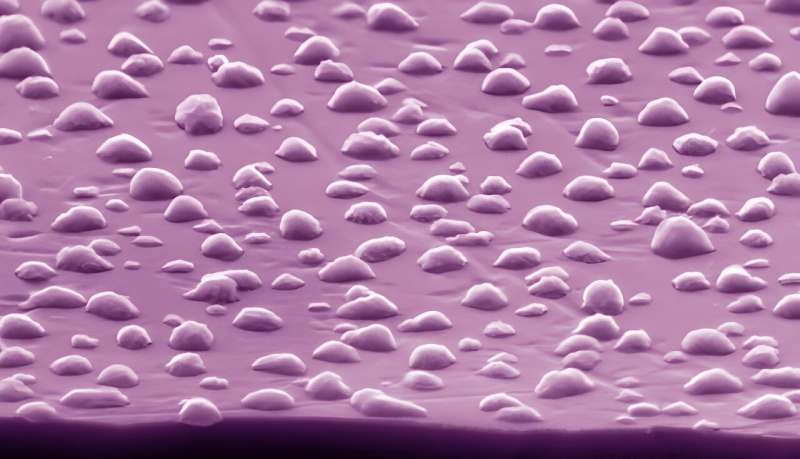This article has been reviewed according to Science X's editorial process and policies. Editors have highlighted the following attributes while ensuring the content's credibility:
fact-checked
peer-reviewed publication
trusted source
proofread
Nanostructured copper surface shows potential for transparent, antimicrobial surfaces in touch displays

The interest in antimicrobial solutions for personal and multi-user touch screens, such as tablets and mobile devices, has grown in recent years. Traditional methods like sprayable alcohols or wipes are not ideal for these delicate displays. Antimicrobial coatings applied directly to the glass are a promising alternative, but only if they are transparent and long-lasting.
Previous proposed coating solutions, such as photocatalytic metal oxides (e.g., TiO2 and ZnO), have posed some challenges. Additionally, these coatings typically require light and moisture to be antimicrobial and eliminate the microbes present on the surface.
Copper is a well-known biocidal metal with high efficacy against a wide range of microorganisms, and it has been traditionally used for objects such as door handles and hospital bedrails.
However, copper coatings are predominantly opaque, which to date has prevented the realization of a transparent, copper-based antimicrobial solution suitable for displays. Furthermore, the high electrical conductivity of the metal film can negatively interfere with the touch-sensing functionality featured on mobile devices.
A team of researchers has designed and implemented a transparent nanostructured copper surface (TANCS) that is non-conductive, and resistant against the growth of certain bacteria. In a recent study, published in the journal Communications Materials, ICFO researchers Christina Graham, Alessia Mezzadrelli led by ICREA Prof. Valerio Pruneri, and colleagues from Corning, including Wageesha Senaratne, Santona Pal, Dean Thelen, Lisa Hepburn and Prantik Mazumder, have described their new approach to develop this surface.
The fabrication process of this surface involved depositing an ultra-thin copper film with a nominal thickness of 3.5nm onto a glass substrate. Then, the researchers used a rapid thermal annealing process to form dewetted Cu nanoparticles with optimal size and distribution.
The specific design and method provided an antimicrobial effect, transparency, color neutrality, and electrical insulation. Finally, additional layers of SiO2 and fluorosilanes were deposited on top of the nanoparticles, providing environmental protection and improved durability properties with use-test cases.
The authors of the study examined the fabricated coating morphology, optical response, antimicrobial efficacy, and mechanical durability. The TANCS showed the ability to eliminate over 99.9% of Staphylococcus aureus present in the tested surfaces within two hours, under stringent dry test conditions.
Moreover, the substrate demonstrated optical transparency allowing for 70–80% light transmission in the visible range (380–750nm), color neutrality. Finally, the surfaces were shown to have a prolonged effectiveness with use-test cases, maintaining their antimicrobial activity even after a rigorous wipe-testing procedure.
"This is a great example of creating a multi-attribute product while co-optimizing the high efficacy antimicrobial properties that work under dry test conditions for touch-enabled, display use test cases.
"Our goal was to show the connections with biological performance and physical attributes, and provide further guidance for future research," said Senaratne, researcher at Corning and leading co-author of the study.
"This new approach of considering the dewetting process opens a variety of new possibilities to exploit some specific properties of metals while being able to thoughtfully change the others.
"Here, for example, we were able to preserve the powerful antimicrobial effect of the copper while obtaining transparency and insulation despite the use of a metal," said Mezzadrelli, author of the study and Ph.D. student of the Nano-Glass project.
The introduction of these transparent antimicrobial surfaces holds significant promise in a world increasingly reliant on touchable displays, including smartphones or tablets.
"While further development is necessary for full-fledged commercial deployment, this is a step in the right direction to enable antimicrobial touch screens for public or personal displays," said Mazumder, researcher at Corning and co-author of the study.
"The proof-of-concept surface we have developed with Corning is an example of our continuous joint efforts in the development of enhanced multifunctional display screen glass using nano-structuring," said Pruneri, ICREA professor at ICFO and coordinator of the Nano-Glass project.
More information: Christina Graham et al, Towards transparent and durable copper-containing antimicrobial surfaces, Communications Materials (2024). DOI: 10.1038/s43246-024-00472-w
Journal information: Communications Materials
Provided by ICFO




















